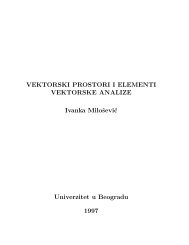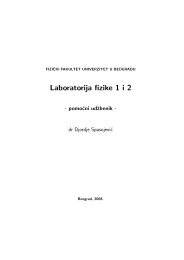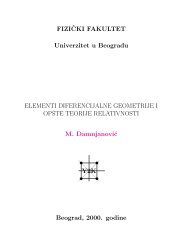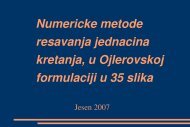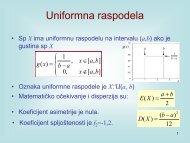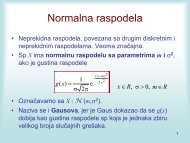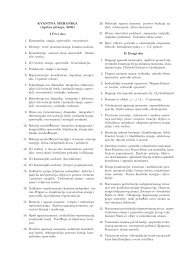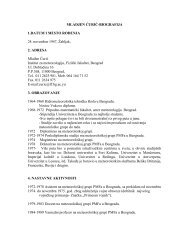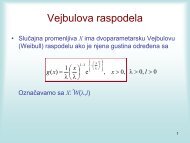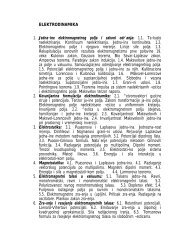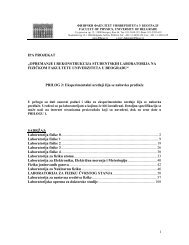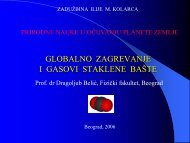BSc final year projects (diploma works), MSc theses and PhD theses ...
BSc final year projects (diploma works), MSc theses and PhD theses ...
BSc final year projects (diploma works), MSc theses and PhD theses ...
- No tags were found...
You also want an ePaper? Increase the reach of your titles
YUMPU automatically turns print PDFs into web optimized ePapers that Google loves.
<strong>BSc</strong> <strong>final</strong> <strong>year</strong> <strong>projects</strong> (<strong>diploma</strong> <strong>works</strong>), <strong>MSc</strong> <strong>theses</strong> <strong>and</strong> <strong>PhD</strong> <strong>theses</strong><br />
defended at the Department for Nuclear <strong>and</strong> Particle Physics in the<br />
period of last five <strong>year</strong>s<br />
<strong>BSc</strong> <strong>final</strong> <strong>year</strong> <strong>projects</strong> (<strong>diploma</strong> <strong>works</strong>)<br />
---------------------------------------------------------------------------------------------------------------------<br />
Ana Umievi<br />
Astrophysical S(E) factor for the reaction 7 Li(p,α) 4 He<br />
The "Trojan horse" method, as applied to this reaction, is discussed in detail <strong>and</strong> its results are<br />
compared to the results of extrapolations of direct measurements <strong>and</strong> recent compilations.<br />
Consequences for the production of light elements in the early Universe <strong>and</strong> in stars are also<br />
discussed.<br />
--------------------------------------------------------------------------------------------------------------------<br />
Emilija Panti<br />
Optimization of light detectors for CRESST dark matter search<br />
The CaWO 4 crystals which are used in the CRESST experiment as the dark matter detector<br />
medium yield both the thermal <strong>and</strong> light output. Here the potentials of silicon-on-sapphire as light<br />
detector absorber are explored <strong>and</strong> it is found suitable as the light detector for the next phase of<br />
the CRESST experiment.<br />
---------------------------------------------------------------------------------------------------------------------<br />
Nikola Novakovi<br />
Measurement of the lifetime of the 59.5 keV state in 237 Np<br />
Alpha particles feeding the 59.5 keV state in 237 Np from the decay of 241 Am were detected by the<br />
silicon light diode situated in a small vacuum chamber, while the 59.5 keV gamma-ray was<br />
detected by the NaI(Tl) scintillation detector. The signals from these detectors were fed to the<br />
TAC where the resolution of some 150 ns was achieved. Slope of the time curve yields the<br />
lifetime of 76 ns, which is well accounted for by the Nilsson model of the involved nuclei.<br />
---------------------------------------------------------------------------------------------------------------------
Vladan Pejovi<br />
The problem of background in the thallium experiment for the solar neutrino flux<br />
measurement<br />
Production of 205 Pb by cosmic-ray muons in thallium minerals is main source of background in<br />
this experiment. It is strongly depth dependent <strong>and</strong> is due to erosion significantly time dependent.<br />
To assess the contribution of slow <strong>and</strong> fast muons to the solar neutrino signal the uniform erosion<br />
model based on the measured 26 Al concentration in adjacent quartz minerals has been developed.<br />
---------------------------------------------------------------------------------------------------------------------<br />
Ivan Smiljani<br />
Limitations of the method for the identification of b-quark events based on the AABTAG<br />
program<br />
The possibilities <strong>and</strong> limitations of the b-tagging method for the identification of b-quark events<br />
were investigated on the complete sample of simulated hadronic events (Z 0 → qq ) at the resonant<br />
Z 0 energy. The generated <strong>and</strong> analyzed events corresponded to the real data collected at the<br />
DELPHI detector. As witnessed by the results of application of many different cuts the b-tagging<br />
method was found suitable for the analysis of these events.<br />
---------------------------------------------------------------------------------------------------------------------<br />
Andrija Mati<br />
Search for the virtual state of the deuteron<br />
The neutrons from the 252 Cf source were passed through a thin plastic scintillator <strong>and</strong> then<br />
through water, <strong>and</strong> the ensuing gamma-rays were measured by the Ge gamma-ray detector in<br />
coincidence with amplitude selected signals from the plastic trigger detector. No significant lines<br />
were found in the spectra. This demonstrates that the existence of the virtual state does not lead to<br />
significant increase of capture cross section at neutron energy which corresponds to the energy of<br />
this state.<br />
---------------------------------------------------------------------------------------------------------------------<br />
Ivana Raievi<br />
Measurements of the neutron background<br />
The background flux of environmental neutrons of different origin (cosmic-rays, fission, nuclear<br />
reactions) was measured by means of the NE213 liquid scintillation detector, using the pulse<br />
shape discriminator technique. The flux was determined at the ground <strong>and</strong> underground (30<br />
m.w.e.) levels, <strong>and</strong> was found to be within the limits determined from the measurements at<br />
similar locations worldwide.<br />
---------------------------------------------------------------------------------------------------------------------
Nenad Vranješ<br />
Jet multiplicity in hadron-hadron interactions at high energies<br />
Monte Carlo simulations of proton-proton collisions at energies of 200, 500, 1000, 2000 <strong>and</strong><br />
14000 GeV were performed using the PYTHIA 6.2 simulation package. The jet multiplicity<br />
density, which carries important information about the interaction, was obtained for zero<br />
pseudorapidity. It has been shown that the multiplicity depends only logarithmically upon<br />
available energy. The parameters of this dependence are obtained explicitly. Also, it has been<br />
demonstrated that spectator jets carry only little information about the interaction.<br />
---------------------------------------------------------------------------------------------------------------------<br />
Dimitrije Maleti<br />
Calibration of the temperature sensor for the needs of temperature control of the CMS<br />
detector<br />
The temperature sensor unit to be used for the temperature control of the electromagnetic<br />
calorimeter of the front end detector of the CMS, composed out of four NTC thermistors, one<br />
RBFE chip, ADC <strong>and</strong> a computer, was assembled <strong>and</strong> calibrated in a heat bath constructed for<br />
this purpose, by means of a mercury thermometer of an accuracy of 0.2 o C. It has been found that<br />
the accuracy of the calibration is satisfactory for this particular need.<br />
---------------------------------------------------------------------------------------------------------------------<br />
Jelena Donev<br />
Spectral response of scintillation detectors to cosmic-ray muons<br />
Program to simulate the spectral response of plastic scintillation detectors of the prismoidal form,<br />
of the thoroidal NaI(Tl) scintillation detector, <strong>and</strong> of the spherical NE343 liquid scintillation<br />
detector to cosmic-ray muons has been developed. The results of the simulation are compared<br />
with experimental spectra <strong>and</strong> the need to take into account the effects of multiple <strong>and</strong> shower<br />
effects for large detectors has been noted.<br />
---------------------------------------------------------------------------------------------------------------------<br />
Jovan Drobnjakovi<br />
Gamma-ray spectrometry of rare-earth compounds<br />
High-resolution gamma-ray spectrometry with germanium detector revealed that 227 Ac is a<br />
companion to lanthanum in its compounds declared as "spectroscopically pure chemicals". Also,<br />
it has been found that significant activity of isotopes from thorium series accompanies cerium in<br />
its compounds. Via the gamma-ray lines from the decay of long-lived naturally occurring isotopes<br />
of lanthanum <strong>and</strong> lutetium <strong>and</strong> the detection absolute efficiency calibration a non-destructive<br />
method for determination of lanthanum <strong>and</strong> lutetium element concentration has been developed.<br />
---------------------------------------------------------------------------------------------------------------------
Dejan Jokovi<br />
Modifications of the liquid drop model of the nucleus<br />
Review of nuclear mass formulas based on the liquid drop model is given. Also, an alternative<br />
mass formula is developed, based on the view of the nucleus as composed of two overlapping<br />
distributions of protons <strong>and</strong> neutrons which, uninhibited by the Pauli principle, coexist within the<br />
same nuclear volume. Two volume <strong>and</strong> surface terms with independent free fitting coefficients<br />
<strong>and</strong> an interaction term with its own coefficient, yield the values of the coefficients which<br />
reproduce the masses of stable isotopes with about the same accuracy as the original liquid drop<br />
mass formula.<br />
---------------------------------------------------------------------------------------------------------------------<br />
Ivana Vukašinovi<br />
Determination of isotope content of uranium by gamma-ray spectrometry<br />
Relative method to determine the isotope content of uranium by high-resolution gamma-ray<br />
spectrometry of the radiations emitted by the samples of mass down to one tenth of a gram is<br />
developed <strong>and</strong> tested up to the accuracy of one percent. The method has been used to assess the<br />
degree of depletion of the uranium used in anti-armor ammunition.<br />
---------------------------------------------------------------------------------------------------------------------<br />
Dejan oki<br />
On the temperature dependence of the surface energy term in the formula for nuclear<br />
binding energy<br />
Temperature dependence of the surface nuclear binding energy term has been established within<br />
the framework of the combined Fermi gas <strong>and</strong> liquid drop nuclear models. The Bohr-Wheeler<br />
model of nuclear fission has also been modified in accordance with this temperature dependence,<br />
<strong>and</strong> temperature dependence of the fission parameter Z 2 /A is obtained, suggesting that at modest<br />
excitations fission becomes possible at lower values of this parameter than follow from the<br />
original model.<br />
---------------------------------------------------------------------------------------------------------------------<br />
Vedrana Gruji<br />
Variations of cosmic-ray intensity <strong>and</strong> the polarity of the interplanetary magnetic field<br />
The data taken by two plastic scintillation detectors which continuously measure the intensity of<br />
cosmic-ray muons at the ground level <strong>and</strong> at the depth of 30 m.w.e. form the two time series for<br />
the <strong>year</strong> 2002 which were analyzed by the periodogram technique for harmonic components with<br />
periods in the range from a day to a <strong>year</strong>. No statistically significant correlation with the polarity<br />
of the interplanetary magnetic field has been found.<br />
---------------------------------------------------------------------------------------------------------------------
Jani Milica<br />
Branching ratios for neutron emission in the decay of neutron-rich nuclei<br />
In the decay of very neutron-rich nuclei beta-delayed neutron emission competes with beta decay,<br />
<strong>and</strong> branching ratios for these decays represent basic observables in these decays. Equations<br />
which govern these processes in three successive decays in a series have been developed here in<br />
detail. They have been applied to the analysis of the complex series of decays which follow the<br />
decay of 33 Na, that have been measured at the University of Jyuvaskyla in fast neutron induced<br />
fission experiments.<br />
---------------------------------------------------------------------------------------------------------------------<br />
Vukosav abarkapa<br />
Simulations of cosmic-ray muon energy losses in nuclear detectors<br />
Program to simulate the passage <strong>and</strong> energy losses of realistic cosmic-ray muon spectrum through<br />
the NaI(Tl) detectors of various shape <strong>and</strong> size is developed. Results of the simulation are<br />
compared to the spectrum of cosmic-ray energy losses in the big NaI(Tl) annular detector which<br />
serves as the cosmic-ray muon veto detector that surrounds the HpGe gamma-ray spectrometer<br />
<strong>and</strong> reduces its background. The program is found to reproduce this spectrum satisfactorily.<br />
---------------------------------------------------------------------------------------------------------------------<br />
Dušan Vudragovi<br />
Measurements of the emittance of an ion beam by the perforated disc method<br />
Ion beam delivered by an ECR ion source is prepared for further transport by a pair of extraction<br />
electrodes the configuration of which determines the emittance of the beam, which should match<br />
the admittance of the beam line. To determine the emittance the beam is let to pass through the<br />
perforated mask <strong>and</strong> to fall on a scintillating screen watched by a video camera. The picture is<br />
then off-line analyzed by the program developed for this purpose. Quality of the beam has been<br />
improved thanks to this development.<br />
---------------------------------------------------------------------------------------------------------------------<br />
Vladimir Simovi<br />
Principles of wavelet analysis in the continuous <strong>and</strong> discrete domain<br />
The orthonormal basis of local oscillatory functions, or wavelets, is demonstrated to be suitable<br />
for the analysis of non-stationary time series. Its advantages in comparison to the window Fourier<br />
transform are analyzed. The sub-coding <strong>and</strong> theory of multi-resolution analysis are developed <strong>and</strong><br />
aliasing is treated in the context of mirror filters. Potentials of wavelet analysis of non-periodic<br />
effects in the variations of cosmic-ray intensity at Earth (Forbush effect, etc.) are discussed.<br />
---------------------------------------------------------------------------------------------------------------------
Bojana Paskaš<br />
Analysis of time series of cosmic-ray muon energy losses in plastic scintillation detectors<br />
Time series of the intensity of the spectrum of cosmic-ray muon energy losses in plastic<br />
scintillation detector situated at the ground level was analyzed by periodogram technique. The<br />
spectrum intensity was integrated beyond the energy loss of 30 MeV, what has been found by the<br />
application of the GEANT4 MC package to correspond to slant muons, incident at zenith angles<br />
greater than 45 o . It has been found that these high-energy muons are modulated by solar rotation<br />
significantly weaker than the close-to-vertical lower energy muons.<br />
---------------------------------------------------------------------------------------------------------------------<br />
Dušan Radevi<br />
Analysis of the full simulation of the ATLAS detector at the LHC by means of the Z o decay<br />
into muons<br />
Four algorithms for muon reconstruction at the future ATLAS detector, named MOORE,<br />
SAMUID, MUCOMB <strong>and</strong> IDMUID, were tested via the muon decay channel of Z o . By<br />
comparisons with the events generated by the Jimmy/HERWIG MC generator it has been<br />
demonstrated that among these the MUCOMB algorithm, which uses the tracks obtained by the<br />
inner detector <strong>and</strong> the muon spectrometer, yields the best results.<br />
---------------------------------------------------------------------------------------------------------------------<br />
Darko Radovanevi<br />
Invariant function for QED lepton-lepton processes in the single-photon approximation<br />
Using the M<strong>and</strong>elstam variables it is demonstrated that the Feynman amplitude averaged over the<br />
initial <strong>and</strong> summed over the <strong>final</strong> spin states for the single-photon exchange lepton-lepton<br />
processes can be expressed via a single invariant function of a simple form. This invariant<br />
function is, for a given process (like the electron-muon <strong>and</strong> electron-electron scattering) quite<br />
easy to write down, what avoids the cumbersome <strong>and</strong> tedious orthodox calculations.<br />
---------------------------------------------------------------------------------------------------------------------<br />
Iris Borjanovi<br />
Reconstruction of the W from the decay of the top at LHC<br />
One of the steps in the determination of the mass of the top quark at the LHC by means of the<br />
kinematical fit from the complete hadronic top-antitop decay is the reconstruction of the mass of<br />
the W. In order to find out the degree to which the reduction of the combinatorial background was<br />
successful it is instructive to determine the efficiency of the reconstruction of the mass of the W.<br />
The simulation is here performed at the parton level <strong>and</strong> it is shown that efficiency of the<br />
reconstruction is in this way quite satisfactory <strong>and</strong> far better than by other methods.<br />
---------------------------------------------------------------------------------------------------------------------
Jelena Ili<br />
Deconvolution of gamma-ray spectra by means of the Monte Carlo method<br />
The Monte Carlo simulation program PHOTON, which is capable of reproducing the spectral<br />
response functions of gamma-ray spectrometers in complex source-detector geometries, was used<br />
in an attempt to deconvolute the continuous spectral structures in gamma-ray spectra. The<br />
background spectrum of the lead shielded HpGe detector has been processed in this way <strong>and</strong> the<br />
continuous part of this spectrum due to bremsstrahlung radiations from lead was approximately<br />
obtained.<br />
---------------------------------------------------------------------------------------------------------------------<br />
Marija Kotur<br />
Double beta decay of germanium-76<br />
The neutrinoless double-beta decay of 76 Ge has been searched for by the measurement of the<br />
background spectrum of a heavily shielded HpGe detector situated in a low-background<br />
laboratory during one week's time. Absence of the line characteristic of this supposed decay<br />
places the lower limit of 10 19 <strong>year</strong>s for the half-life of this decay mode at the 68%CL.
<strong>MSc</strong> Theses<br />
------------------------------------------------------------------------------------------------------------<br />
Vladimir Udovii<br />
Development <strong>and</strong> application of the method for neutron detection in presence of<br />
gamma radiation<br />
The discrimination between the neutrons <strong>and</strong> gamma rays was achieved with the NE213<br />
liquid scintillator detector <strong>and</strong> making use of the difference in anode pulse rise-times for<br />
these two types of radiation. For pulse shape discrimination st<strong>and</strong>ard modular electronics<br />
was used. The results obtained were equal or better than those reported in the literature.<br />
Also, the problem of detecting neutrons from pulsed neutron sources, like the deuterium<br />
plasma focus device, was satisfactorily solved by using the solid-state nuclear track<br />
detectors (mica), <strong>and</strong> neutron yield was reliably determined by this technique.<br />
------------------------------------------------------------------------------------------------------------<br />
Iris Borjanovi<br />
Search for the signal of supersymmetry in the ATLAS experiment<br />
Masses of SUSY particles can be reconstructed from the kinematic boundaries of<br />
different invariant masses formed out of <strong>final</strong> state particles. This method is here applied<br />
to the leptonic decay of the left squark <strong>and</strong> the decay of the gluino to stop <strong>and</strong> top quark.<br />
The first of these consists of the series of three successive decays which in the <strong>final</strong> state<br />
have the two leptons of the same flavor <strong>and</strong> opposite charge, one jet <strong>and</strong> the lightest<br />
neutralino that can not be detected. The obtained kinematic boundaries are used to<br />
reconstruct the masses of the left squark, of the first <strong>and</strong> second neutralino, <strong>and</strong> the right<br />
slepton. Relative errors of reconstructed masses range from 8 to 29 %.<br />
------------------------------------------------------------------------------------------------------------<br />
Milena Bogdanovi<br />
Statistical significance of information in the gamma-ray spectra when the counts per<br />
channel are small<br />
Reconciliation of the two confronted schools of thought in probability theory, the<br />
frequentist <strong>and</strong> the Bayesian, is attempted when applied to the treatment of Poissonian<br />
counts in high-resolution gamma-ray spectroscopy. The concept of the knowledge<br />
density function instead of the maximum likelihood function is introduced <strong>and</strong> the<br />
algorithm typical of the Bayesian approach is then applied to the treatment of Poissonian
spectral data. The method is applied to the analysis of the gamma-ray spectrum of the<br />
Heisenberg-Moscow Ge-76 experiment which produced the controversial result for the<br />
neutrinoless double beta decay of this isotope.<br />
------------------------------------------------------------------------------------------------------------<br />
Goran Mani<br />
Detection limits for radioactivity of environmental samples<br />
Three different internationally recognized <strong>and</strong> recommended definitions of detection<br />
limits, or minimum detectable concentration, are explored <strong>and</strong> compared for the cases of<br />
alpha counting, total beta counting <strong>and</strong> gamma-ray spectroscopy with low (NaI(Tl)) <strong>and</strong><br />
high resolution (Ge) detectors for environmental samples of air, water <strong>and</strong> soil. These<br />
results are compared to a number of other possible <strong>and</strong> occassionally used definitions for<br />
detection limits. Careful analysis of the influence of the division of total measurement<br />
time to background <strong>and</strong> sample measurement is also performed. Recommendations for<br />
everyday practice are issued.<br />
------------------------------------------------------------------------------------------------------------<br />
Nataša Žiki<br />
Comparative study of double-beta decays of magic <strong>and</strong> near-magic nuclei<br />
Four isotopes in the vicinity of the Z, N=28 magic number are susceptible to double<br />
positron or electron capture decay <strong>and</strong> two of these were searched for in this work via the<br />
search for an intensity of the annihilation line in excess of background intensity in HPGe<br />
gamma-ray spectra. The decays were 50 CR<br />
50 Ti, <strong>and</strong> 64 Zn<br />
64 Ni, which both<br />
complete the N or Z = 28 magic number <strong>and</strong> should have favorable nuclear matrix<br />
elements for this decay. The obtained limiting values for the half-lives are more stringent<br />
than the previously existing ones. Other results for double beta decays of otherwise stable<br />
nuclei in the vicinity of magic numbers are analysed <strong>and</strong> some evidence is found to<br />
support the conjecture that decays that complete the magic number configuration are<br />
enhanced as compared to those that destroy this configuration.<br />
------------------------------------------------------------------------------------------------------------<br />
Mila P<strong>and</strong>urovi<br />
Measurements of cross-sections for (n,n'γ) reactions on natural lead at energies in<br />
the range from 0 to 7 MeV<br />
The pulsed neutron beam from the installation GELINA with an energy spectrum<br />
streching effectively up to 10 MeV was used to excite the natural lead target <strong>and</strong> the<br />
gamma-ray burst following the (n,n'γ) reactions was analyzed by the CLOVER type
HPGe detector in coincidence with the beam. To deal with the great counting rate, the<br />
pulses were digitized by a fast ADC <strong>and</strong> the gamma-ray spectrum off-line processed by<br />
the trapezoid algorithm <strong>and</strong> the program developed for this purpose. The results for the<br />
cross-sections for the observed reactions were compared to the theoretical values as<br />
produced by the TALYS code, <strong>and</strong> agreement to within 10% was found.<br />
------------------------------------------------------------------------------------------------------------<br />
Milorad Šiljegovi<br />
Optimization of ion-sources of the electron resonance type<br />
The good properties of ECR ion sources, like the high-charge state of delivered ions,<br />
which are due to high plasma temperature, strong magnetic field at extraction, <strong>and</strong> the<br />
like, at the same time induce high transversal emittance of the beam, what limits the ion<br />
current <strong>and</strong> degrades the quality of the beam. This work is the detailed study of the<br />
parameters that influence the emittance, aimed at compromising between the two<br />
opposed sets of influences <strong>and</strong> achieving the wanted characteristics of the beam for a<br />
given purpose. Recommendations concerning extraction electrode configuration for<br />
different ion species are given in detail.<br />
------------------------------------------------------------------------------------------------------------<br />
Marko Zupan<br />
Energy measurements of high-energy photons in the front-end detector of the CMS<br />
Front-end detector of the CMS consists of the shower detector <strong>and</strong> electromagnetic<br />
calorimeter. Resolution of photon energy determination is critical in detection of the<br />
Higgs decay into two photons <strong>and</strong> the determination of their invariant mass, or the mass<br />
of the Higgs. Simulations performed by the CMSIM package have shown that the<br />
corrections for the energy deposited in the shower detector have positive effect on<br />
resolution. Also, it has been shown that corrections for the position of the shower kernel<br />
further improve the resolution, which can thus be brought to the vicinity of 1%, sufficient<br />
for Higgs mass determination, provided this is smaller than 130 GeV.<br />
------------------------------------------------------------------------------------------------------------<br />
Laslo Naer<br />
Experimental check of the exponential decay of 198-Au<br />
Exact quantum mechanical approach to the decay of the stationary excited eigen-state od<br />
a quantum system predicts non-exponential behavior for extremely short <strong>and</strong> extremely<br />
long times as compared to the mean lifetime of the state in question. An experiment to<br />
test the exponential nature of the radioacative decay of 198-Au with the highest possible
accuracy has been set, <strong>and</strong> the results of this experiment were most carefully analyzed for<br />
possible deviations of the common wisdom exponential character of the decay. The decay<br />
has, with great effort, been followed through 26 half-lives of the isotope. Apart from an<br />
unpredicted period of 4.57 half-lives of this decay, with a chi-square of 1.1, which has<br />
been found in the data, <strong>and</strong> which did not find any interpretation within the existing<br />
quantum mechanical framework, the behavior is nicely exponential, with the half-life<br />
corresponding within error to the world average.<br />
------------------------------------------------------------------------------------------------------------<br />
Ivana Vukanac<br />
Non-nuclear applications of ionization chambers<br />
The conductive current in an AC ionization chamber is due to the drift of ions of both<br />
signs, while the capacitive current is due to the asymmetric modulation of the electric<br />
field in the chamber. In a DC chamber there is only the conductive component. AC<br />
chambers thus appear more sensitive to the presence of chemical vapors within the<br />
working volume. Average ion mobility depends on vapor concentration logarithmically,<br />
<strong>and</strong> this dependence has been established both experimentally <strong>and</strong> theoretically, by<br />
solving the system of differential equations, which govern the behavior of the chamber.<br />
The chamber has been proved a satisfactory sensor for chemical vapors with the<br />
sensitivity that may be considered sufficient for some applications.<br />
------------------------------------------------------------------------------------------------------------<br />
Radomir Banjanac<br />
Optimization of the characteristics of the low-background underground laboratory<br />
The site of the would-be low-background underground nuclear laboratory (about 30<br />
m.w.e.) dedicated to low activity measurements for the needs of both fundamental <strong>and</strong><br />
applied research has been thoroughly examined for levels of all sorts of environmental<br />
radiations in order to assess the suitability for this purpose, prior to beginning of<br />
construction <strong>works</strong>. This greatly helped to define the conditions for the project of the<br />
laboratory. During the <strong>works</strong> <strong>and</strong> upon the completion all the parameters of interest were<br />
measured <strong>and</strong> background reduction was found equal or better than planned. Among<br />
other measures for reduction of background, radon reduction down to the level of 10<br />
Bq/m 3 was achieved by lining <strong>and</strong> sealing the whole working area (of some 60 m 2 ) with<br />
aluminium sheet, <strong>and</strong> pumping in the air through a battery of filters up to an overpressure<br />
of 2 to 3 mbar.<br />
------------------------------------------------------------------------------------------------------------<br />
Aleks<strong>and</strong>ar Dragi
On the existence of resonant states of positronium<br />
Resonant states of positronium turned out to be of special interest after the discovery of<br />
lines in positron spectra resulting from heavy ion collisions. In this work non-perturbative<br />
contributions of magnetic interaction at small disances are studied. The spectrum of<br />
positronium bound states is calculated using the self-consistent Barut-Vigier model <strong>and</strong><br />
the 3 P 0 channel is explored for the existence of resonances. Two techniques were used;<br />
that of the complex coordinate rotation <strong>and</strong> the calculation of phase shifts. Phase shifts<br />
were calculated by direct numerical integration of the Schrodinger equation <strong>and</strong> by the<br />
method of phase functions. In neither case the resonances were found.
<strong>PhD</strong> <strong>theses</strong><br />
Goran Škoro<br />
Studies of few-nucleon systems by polarized <strong>and</strong> unpolarized beams of light nuclei<br />
Experiments concerning pion production in interactions of polarized deuterons with<br />
momentum in the range from 3 to 9 GeV/c with different light nuclei are analyzed <strong>and</strong><br />
spin dependence of these processes is discussed in detail. Also, interactions of highenergy<br />
unpolarized light nuclei are studied with emphasis on establishing the threshold at<br />
which scaling sets in, <strong>and</strong> finding the differential cross sections for these processes.<br />
Structure nuclear functions are treated in detail. Among the results of interest there is the<br />
finding that the spin asymmetry has a maximum of about 40% at low deuterium<br />
momentum while it almost disappears at higher momenta, <strong>and</strong> that in unpolarized protonnucleus<br />
interactions scaling sets in at the momentum of 4.5 GeV/c.<br />
------------------------------------------------------------------------------------------------------------<br />
Jovan Puzovi<br />
Contributions of cosmic rays to the background spectra of high-resolution gammaray<br />
spectrometers<br />
The production of annihilation radiation by cosmic rays (mostly muons) at sea level in<br />
Al, Fe, Sn <strong>and</strong> Pb is measured by means of a triggered HPGe detector. A large plastic<br />
scintillation detector 5 cm thick with a good discrimination of background radiations<br />
from cosmic-ray muons, served as a trigger detector. The complex Monte Carlo<br />
simulation of the whole creation <strong>and</strong> detection process was developed, <strong>and</strong> absolute<br />
detection efficiency was thus derived. Production rate of positrons per unit mass of the<br />
material is found to be proportional to the square of the atomic number of the material<br />
divided by its mass number, with the proportionality constant equal to 8.1(3)e-6/s.g.<br />
------------------------------------------------------------------------------------------------------------<br />
Ivana Piuri<br />
Collective effects in C+C <strong>and</strong> C+Ta interactions at 4.2A GeV/c<br />
Experimental invariant distributions of transverse momenta of negative pions <strong>and</strong> protons<br />
resulting from central collisions <strong>and</strong> central region of rapidity in C+C <strong>and</strong> C+Ta<br />
interactions at 4.2 GeV/c per nucleon are studied. The distributions are analyzed within<br />
the framework of transverse collective motion <strong>and</strong> boundary models. Invariant mass
spectra of ∆ ++ <strong>and</strong> ∆ 0 resonances in C+C interactions were obtaind <strong>and</strong> fitted with Breit-<br />
Wigner shapes. Masses of resonances agree with those from earlier studies, while their<br />
widths are by a factor of two smaller than found before. Practically the same number of<br />
∆ ++ <strong>and</strong> ∆ 0 resonances is observed what means that about 35% of pions <strong>and</strong> 25% of<br />
protons are due to the decay of these resonances.<br />
------------------------------------------------------------------------------------------------------------<br />
Stanko Dapevi<br />
Multiparameter optimization of gamma-ray spectrometric measurements of low<br />
specific radioactivity<br />
Semi-empirical method for absolute efficiency determination in high-resolution gammaray<br />
spectrometry of cylindrical voluminous sources of low specific activity <strong>and</strong> of<br />
different composition characteristic of environmental samples has been developed,<br />
including the case of non-coaxial positioning of the source <strong>and</strong> the detector, <strong>and</strong> the case<br />
when the radius of the source exceeds that of the detector. The method has also been<br />
extended to include the geometry of the Marinelli source. Dependence of the absolute<br />
detection efficiency on all the relevant parameters has been studied in detail both<br />
experimentally <strong>and</strong> theoretically. Most important recommendations concern the optimum<br />
shape of the cylindical source, the optimum radius-to-height ratio, etc. The errors that<br />
arise from incomplete knowledge of different parameters of the detector <strong>and</strong> the source,<br />
from eventual mispositioning of the source, etc. have also been estimated.<br />
------------------------------------------------------------------------------------------------------------<br />
Zoran Miloševi<br />
On the stopping power <strong>and</strong> energy-loss distributions for α-rays in different media<br />
Classical <strong>and</strong> relativistic treatment in the first Born approximation of the passage of<br />
charged particles through matter are reviewed in detail. All the known corrections, for<br />
shell effects, density effect, Barkas <strong>and</strong> Bloch corrections, correction for effective charge<br />
of the incoming particle, are included. Precise measurements of the stopping power for<br />
alpha particles in noble gasses, nitrogen <strong>and</strong> oxygen are performed with errors not<br />
exceeding 0.7%. Parameters of correction terms were thus fixed <strong>and</strong> general formula<br />
completed. Measurements of the width of the distribution of energy losses were also<br />
performed <strong>and</strong> these were compared to those given by the approximate analytical formula<br />
for the width which is obtained by solving the Symon's equations for the second <strong>and</strong> third<br />
order of central moments. The agreement was found satisfactory even for thick targets,<br />
when energy loss amounts up to 70% of the initial energy.
Research work performed by the staff of the Department for Nuclear<br />
<strong>and</strong> Particle Physics in the period of last five <strong>year</strong>s<br />
________________________________________________________________________<br />
The members of the Department were during the period of last five <strong>year</strong>s engaged in the<br />
realization of three major scientific research programs funded by the Ministry of Science<br />
<strong>and</strong> Environment Protection of the Republic of Serbia:<br />
1. High Energy Particle Physics (Project No. 1488)<br />
2. Low-energy nuclear reactions (Project No. 1461)<br />
3. Nuclear Spectroscopy <strong>and</strong> rare nuclear processes (Project No. 1859)<br />
They also participated in a number of international scientific collaborations:<br />
1. The CMS (Compact Muon Solenoid) collaboration at LHC, CERN, Geneva<br />
2. The RHIC (Relativistic Heavy Ion Collider) collaboration at Brookhaven<br />
3. The ILIAS (Integrated Large Infrastructures for AStroparticle physics) FP6 European<br />
Framework Project.<br />
And their output during that period was as follows:<br />
________________________________________________________________________<br />
J.M. Puzovic <strong>and</strong> I.V.Anicin<br />
“Production of positron annihilation radiation by cosmic-rays near sea-level”;<br />
Nucl Instr & Meth in Phys Res, A480 (2002) 565 – 570<br />
I. Bikit, N. Zikic-Tordorivic, J. Slivka, M. Veskovic, M. Krmar, C. Conckic, J. Puzovic,<br />
I.V. Anicin<br />
“Double beta decay of Cr-50”.<br />
Phys.Rev. C67 (2003) 658<br />
S.Dragovic, A.Onjia, S.Stankovic, I.Anicin, G.Bacic:<br />
"Artificial neural network modelling of uncertainty in gamma-ray spectrometry"<br />
Nucl Instr & Meth in Phys Res, A540 (2005) 455 – 463<br />
P.R.Adzic,…I.Anicin,… S.Drndarevic,…D.Krpic, … J.Puzovic,….<br />
"Recent results on system aspects of the CMS electromagnetic calorimeter"<br />
CMS Note, CERN, Geneva June 9, 2005
I. Anicin:<br />
“The neutrino - its past, present <strong>and</strong> future”;<br />
12th Yugoslav Conference on Nuclear <strong>and</strong> Particle Physics; September 17-19, 2001;<br />
Studenica; Serbia <strong>and</strong> Montenegro; Nuclear <strong>and</strong> Particle Physics, SFIN Series A; A2<br />
(2002) 3 - 59;<br />
R.Banjanac, A.Dragic, D.Jokovic, V.Udovicic, J.Puzovic, I.Anicin:<br />
“Continuous monitoring of environmental radioactivity in Belgrade”;<br />
1st International Meeting on Applied Physics; October, 13-18, 2003; Badajoz;<br />
Spain; p.128<br />
A.Dragic, V.Udovicic, R.Banjanac, D.Jokovic, I.Anicin:<br />
“Bayesian analysis of low radioactivity measurements”;<br />
Fifth General Conference of the Balkan Physical Union; August 25-29, 2003;<br />
Vrnjacka Banja; Serbia <strong>and</strong> Montenegro; Vol. 1 (2003); 81 - 84;<br />
R.Antanasijevic, D.Joksimovic, V.Udovicic, A.Dragic, J.Stanojevic, R.Banjanac,<br />
D.Jokovic, I.Anicin;<br />
“The neutron background measurement at the low-level underground laboratory in<br />
Zemun”;<br />
12th Yugoslav Conference on Nuclear <strong>and</strong> Particle Physics; September, 17-19,<br />
2001; Studenica; Serbia <strong>and</strong> Montenegro; Nuclear <strong>and</strong> Particle Physics, SFIN<br />
A2 (2002); 170 - 173;<br />
R.Antanasijevic, D.Joksimovic, V.Udovicic, A.Dragic, J.Stanojevic, R.Banjanac,<br />
D.Jokovic, I.Anicin, J.Puzovic:<br />
“Transport of the U-oxides through the ground”;<br />
12th Yugoslav Conference on Nuclear <strong>and</strong> Particle Physics; September, 17-19,<br />
2001; Studenica; Serbia <strong>and</strong> Montenegro; Nuclear <strong>and</strong> Particle Physics, SFIN<br />
A2 (2002); 194 - 198;<br />
J.Puzovic, I.Anicin:<br />
“An off-line method for amplitude independent timing”;<br />
12th Yugoslav Conference on Nuclear <strong>and</strong> Particle Physics; September, 17-19,<br />
2001; Studenica; Serbia <strong>and</strong> Montenegro; Nuclear <strong>and</strong> Particle Physics, SFIN<br />
A2 (2002); 183 - 186;<br />
Z.Radivojevic, I.Anicin, …, J.Puzovic, …, G.Skoro:<br />
“Numerical Simulation for Unfolding of Complex Activities in Case of 33-Na Decay”<br />
XXXV Annual Conference of the Finish Physical Society, Jyvaskyla, 2001,<br />
p. 217<br />
I.Bikit, J.Slivka, M.Krmar, I.Anicin, M.Veskovic, N.Zikic, Lj.Conkic<br />
“Double Beta Decay <strong>and</strong> the Properties of the Neutrino”<br />
Proceedings for Natural Sciences No. 100, Matica Srpska, Novi Sad 2001
D.S.Mrdja, I.S.Bikit, I.V.Anicin, J.M.Slivka, J.J.Hansman, N.M.Zikic-Todorovic,<br />
E.Z.Varga, S.M.Curcic, J.M.Puzovic:<br />
“Background Reduction Using Fe <strong>and</strong> Pb Shielding”<br />
J.Res.Phys, 29(2004)65<br />
N.Zikic-Todorovic, I.Bikit, J.Slivka, M.Veskovic, M.Krmar, Lj.Conkic, E.Varga,<br />
S.Curcic, D.Mrdja, J.Puzovic, I.Anicin<br />
“0v Mode in Double Beta Decay of 50-Cr”<br />
J.Res. Phys. 29(2004)77<br />
I. Aniin, R. Banjanac, A. Dragi, B. Grabež, D. Jokovi, D. Joksimovi, Z. Mari,<br />
B.Pani, V. Udovii.<br />
"Flux <strong>and</strong> energy distribution of the axial protons emitted from the hydrogen plasma<br />
focus"<br />
22 nd Int. Conference on Nuclear Tracks in Solids, Barcelona, Spain, August 23-27, 2002.<br />
Book of Abstracts (2004) 169.<br />
I. Aniin, R. Banjanac, A. Dragi, B. Grabež, D. Jokovi, V. Udovii.<br />
"Variations of radon concentration in the low-level laboratory in Belgrade"<br />
22 nd Int. Conference on Nuclear Tracks in Solids, Barcelona, Spain, August 23-27, 2002.<br />
Book of Abstracts (2004) 249.<br />
I.V.Anicin:<br />
"Late-Night Thoughts About the Significance of a Small Count of Nuclear or Particle<br />
Events"<br />
e-Print Archive:http://archiv.org/abs/physics/0501108<br />
I.V.Anicin:<br />
"The Neutrino - Its Past, Present <strong>and</strong> Future"<br />
e-Print Archive: http://archiv.org/abs/physics/0503172<br />
J. Puzovi, A. Dragi, V. Udovii, D. Jokovi, R. Banjanac, I. Aniin<br />
"Analysis of continuous cosmic-ray measurements in Belgrade"<br />
28th International Cosmic Ray Conference; July 31 - August 07, 2003; Tsukuba; Japan;<br />
Proceedings of the 28th International Cosmic Ray Conference (2003) 1199 – 1202.<br />
I.Aniin, R. Banjanac, A. Dragi, D. Jokovi, V. Udovii<br />
"Investigation of the uranium solubility <strong>and</strong> absorption"<br />
Physica Scripta, Vol. T118 (2005) 39<br />
I. Aniin, R. Banjanac, A. Dragi, B. Grabež, D. Jokovi, D. Joksimovi, Z. Mari,<br />
B.Pani, V. Udovii.<br />
"Flux <strong>and</strong> energy distribution of the axial protons emitted from the hydrogen plasma<br />
focus"<br />
Radiation Measurements, Vol. 39 (2005)
A.Dragi, R. Banjanac, V. Udovii, D. Jokovi, I. Aniin, J. Puzovi<br />
"Comparative study of power spectra of ground <strong>and</strong> shallow underground muon data"<br />
Int. J. Mod. Phys. A (2005) in press<br />
I. Zborovsky, Y. A. Panebratsev, M. V. Tokarev, G. P. Skoro<br />
"A-Dependence Of Z-Scaling".<br />
Int. J. Mod. Phys. A16:1281-1302, 2001<br />
I. Zborovsky, Y. A. Panebratsev, M. V. Tokarev, G. P. Skoro<br />
"Z-scaling, fractality <strong>and</strong> principle of relativity in relativistic collisions of hadrons <strong>and</strong><br />
nuclei".<br />
International Conference on Ultrarelativistic Nucleus-Nucleus Collisions (QM2001),<br />
Stony Brook, New York, 15-20 January 2001.<br />
M. V. Tokarev, Y. A. Panebratsev, G. P. Skoro, I. Zborovsky<br />
"Self-similarity of high-p(t) hadron production in pi-p <strong>and</strong> pi-a collisions".<br />
JINR-E2-2002-251, Dec 2002., 10pp. 16th International Conference on Ultrarelativistic<br />
Nucleus-Nucleus Collisions: Quark Matter 2002 (QM 2002), Nantes, France, 18-24 Jul<br />
2002.<br />
G. P. Skoro<br />
"Identification of gamma+jet events at STAR (RHIC)".<br />
XII Yu Conference on Nuclear <strong>and</strong> Particle Physics, Studenica, 2001, p.193-196.<br />
G. P. Skoro <strong>and</strong> M. V. Tokarev<br />
"Asymmetry of polarized-p + polarized-p ---> gamma + jet + x process <strong>and</strong> problem of<br />
delta g".<br />
e-Print Archive: hep-ph/0009028; STAR Note 425.<br />
Lj. Simic, G. Skoro, I. Mendas <strong>and</strong> D. Popovic<br />
"Measurement of top quark mass in hadronic channel at the LHC".<br />
XII Yu Conference on Nuclear <strong>and</strong> Particle Physics, Studenica, 2001, p.221-224.<br />
I. Borjanovic, Lj. Simic, G. Skoro <strong>and</strong> D. Popovic<br />
"gg decay mode for higgs produced in the weak boson fusion at the LHC".<br />
XII Yu Conference on Nuclear <strong>and</strong> Particle Physics, Studenica, 2001, p.225-228.<br />
Lj. Simic, I. Borjanovic, G. Skoro <strong>and</strong> D. Popovic<br />
"Predictions of leading order QCD generators for hadronic top quark decay at the LHC".<br />
XII Yu Conference on Nuclear <strong>and</strong> Particle Physics, Studenica, 2001, p.229-232.<br />
J. Ilic <strong>and</strong> G. Skoro<br />
"An Algorithm For Finding The Vertex Of A H->Gg Decay In The Presence Of Pileup<br />
From Minimum Bias Events In CMS At The LHC."<br />
Proc. of the V General Conference of the Balkan Physical Union, Vrnjacka Banja, 2003,<br />
p.419-424.
D. Krpic, S. Drndarevic, J. Ilic, G. Skoro, …, S. Backovic<br />
"Higher baryon resonances in carbon-carbon collisions at 4.2 Gev/c per nucleon."<br />
The European Physical Journal A, 2004 (accepted)<br />
I. Picuric, S. Backovic, D. Krpic, G. Skoro, S. Drndarevic<br />
"Analyses of transverse momentum spectra of baryon resonances in C+C collisions at 4,2<br />
AGev/c."<br />
XII Yu Conference on Nuclear <strong>and</strong> Particle Physics, Studenica, 2001, p.211-214.<br />
D. Krpic, S. Drndarevic, J. Ilic, G. Skoro, …, S. Backovic<br />
"Roper resonance in carbon-carbon collisions at 4.2 Gev/c per nucleon"<br />
Proc. of the V General Conference of the Balkan Physical Union, Vrnjacka Banja, 2003,<br />
p.453-456<br />
C. Adler, Z. Ahammed, ..., G. Skoro, …, A.N. Zubarev (STAR Collaboration)<br />
Measurement of inclusive anti-protons from Au+Au collisions at s(nn)**(1/2) = 130Gev.<br />
Phys. Rev. Lett. 87:262302, 2001<br />
C. Adler, Z. Ahammed, ..., G. Skoro, …, A.N. Zubarev (STAR Collaboration)<br />
Anti-deuteron <strong>and</strong> anti-He-3 production in s(nn)**(1/2)=130Gev Au+Au collisions.<br />
Phys. Rev. Lett. 87:262301, 2001<br />
C. Adler, Z. Ahammed, ..., G. Skoro, …, A.N. Zubarev (STAR Collaboration)<br />
Pion interferometry of s(nn)**(1/2) = 130 Gev Au+Au collisions at RHIC.<br />
Phys. Rev. Lett. 87:082301, 2001<br />
C. Adler, Z. Ahammed, ..., G. Skoro, …, A.N. Zubarev (STAR Collaboration)<br />
Identified particle elliptic flow in Au+Au collisions at s(nn)**(1/2)=130 Gev.<br />
Phys. Rev. Lett. 87:182301, 2001<br />
C. Adler, Z. Ahammed, ..., G. Skoro, …, A.N. Zubarev (STAR Collaboration)<br />
Multiplicity distribution <strong>and</strong> spectra of negatively charged hadrons in Au+Au collisions<br />
at s(nn)**(1/2)=130 Gev.<br />
Phys. Rev. Lett. 87:112303, 2001<br />
C. Adler, Z. Ahammed, ..., G. Skoro, …, A.N. Zubarev (STAR Collaboration)<br />
Midrapidity anti-proton to proton ratio from Au+Au collisions at s(nn)**(1/2)=130 Gev.<br />
Phys. Rev. Lett. 86:4778-4782, 2001<br />
K. H. Ackermann, N. Adams, ..., G. Skoro, …, A.N. Zubarev (STAR Collaboration)<br />
Elliptic flow in Au+Au collisions at s(nn)**(1/2)=130 Gev<br />
Phys. Rev. Lett. 86:402-407, 2001<br />
L.S. Barnby, C. Adler, Z. Ahammed, ..., G. Skoro, …, A.N. Zubarev (STAR<br />
Collaboration)
Strangeness in Au+Au collisions at s(nn)**(1/2)=130 Gev observed with the STAR<br />
detector.<br />
J. Phys. G28:1535-1542, 2002<br />
C. Adler, Z. Ahammed, ..., G. Skoro, …, A.N. Zubarev (STAR Collaboration)<br />
Midrapidity phi production in Au+Au collisions at s(nn)**(1/2)=130 Gev.<br />
Phys. Rev. C65:041901, 2002<br />
C. Adler, Z. Ahammed, ..., G. Skoro, …, A.N. Zubarev (STAR Collaboration)<br />
Midrapidity lambda <strong>and</strong> anti-lambda production in Au+Au collisions at s(nn)**(1/2)=130<br />
Gev<br />
Phys. Rev. Lett. 89:092301, 2002<br />
C. Adler, Z. Ahammed, ..., G. Skoro, …, A.N. Zubarev (STAR Collaboration)<br />
Results from the star experiment.<br />
Nucl. Phys. A698:64-77, 2002<br />
C. Adler, Z. Ahammed, ..., G. Skoro, …, A.N. Zubarev (STAR Collaboration)<br />
Coherent rho0 production in ultraperipheral heavy ion collisions.<br />
Phys. Rev. Lett. 89:272302, 2002<br />
C. Adler, Z. Ahammed, ..., G. Skoro, …, A.N. Zubarev (STAR Collaboration)<br />
Elliptic flow from two <strong>and</strong> four particle correlations in Au+Au collisions at<br />
s(nn)**(1/2)=130 Gev<br />
Phys. Rev. C66:034904, 2002<br />
C. Adler, Z. Ahammed, ..., G. Skoro, …, A.N. Zubarev (STAR Collaboration)<br />
K*(892)0 production in relativistic heavy ion collisions at s(nn)**(1/2) = 130 Gev<br />
Phys. Rev. C66:061901, 2002<br />
C. Adler, Z. Ahammed, ..., G. Skoro, …, A.N. Zubarev (STAR Collaboration)<br />
Azimuthal anisotropy of k0(s) <strong>and</strong> lambda + anti-lambda production at mid-rapidity from<br />
Au+Au collisions at s(nn)**(1/2)=130 Gev<br />
Phys. Rev. Lett. 89:132301, 2002<br />
C. Adler, Z. Ahammed, ..., G. Skoro, …, A.N. Zubarev (STAR Collaboration)<br />
Centrality dependence of high p(t) hadron suppression in Au+Au collisions at<br />
s(nn)**(1/2)=130 Gev<br />
Phys. Rev. Lett. 89:202301, 2002<br />
C. Adler, Z. Ahammed, ..., G. Skoro, …, A.N. Zubarev (STAR Collaboration)<br />
Azimuthal anisotropy <strong>and</strong> correlations in the hard scattering regime at RHIC<br />
Phys. Rev. Lett. 90:032301, 2003<br />
K. H. Ackermann, N. Adams, ..., G. Skoro, …, A.N. Zubarev (STAR Collaboration)
STAR detector overview<br />
Nucl. Instrum. Meth. A499:624-632, 2003<br />
J. Adams, C. Adler, ..., G. Skoro, …, A.N. Zubarev (STAR Collaboration)<br />
Strange anti-particle to particle ratios at mid-rapidity in Au+Au collisions at<br />
s(nn)**(1/2)=130 Gev<br />
Phys. Lett. B567:167-174, 2003<br />
C. Adler, Z. Ahammed, ..., G. Skoro, …, A.N. Zubarev (STAR Collaboration)<br />
Disappearance of back-to-back high p(t) hadron correlations in central Au+Au collisions<br />
at s(nn)**(1/2)=130 Gev<br />
Phys. Rev. Lett. 90:082302, 2003<br />
J. Adams, C. Adler, ..., G. Skoro, …, A.N. Zubarev (STAR Collaboration)<br />
Narrowing of the balance function with centrality in Au+Au collisions at<br />
s(nn)**(1/2)=130 Gev<br />
Phys. Rev. Lett. 90:172301, 2003<br />
J. Adams, C. Adler, ..., G. Skoro, …, A.N. Zubarev (STAR Collaboration)<br />
Transverse momentum <strong>and</strong> collision energy dependence of high p(t) hadron suppression<br />
in Au+Au collisions at ultrarelativistic energies<br />
Phys. Rev. Lett. 91:172302, 2003<br />
J. Adams, C. Adler, ..., G. Skoro, …, A.N. Zubarev (STAR Collaboration)<br />
Evidence from d+Au measurements for <strong>final</strong> state suppression of high p(t) hadrons in<br />
Au+Au collisions at RHIC<br />
Phys. Rev. Lett. 91:072304, 2003<br />
J. Adams, C. Adler, ..., G. Skoro, …, A.N. Zubarev (STAR Collaboration)<br />
Three pion hbt correlations in relativistic heavy ion collisions from the STAR<br />
experiment<br />
Phys. Rev. Lett. 91:262301, 2003<br />
J. Adams, C. Adler, ..., G. Skoro, …, A.N. Zubarev (STAR Collaboration)<br />
Pion kaon correlations in Au+Au collisions at s(nn)**(1/2)=130 Gev<br />
Phys. Rev. Lett. 91:262302, 2003<br />
J. Adams, C. Adler, ..., G. Skoro, …, A.N. Zubarev (STAR Collaboration)<br />
Multiplicity fluctuations in Au+Au collisions at s(nn)**(1/2)=130 Gev<br />
Phys. Rev. C68:044905, 2003



